With necks that swivel through 270 degrees, ungodly active hours, no teeth, and three eyelids, owls are undoubtedly some of the most intriguing creatures in the world. That’s not even the end of it! Their behavior, plumage, and size vary in fascinating ways, too.
Luckily, Washington has enough owl species to keep you entertained and intrigued for a long time. In this article, we cover all 15 of these species so that it’s easier for you to spot them.
National parks, wildlife refuges, and, of course, the Great Washington State Birding Trail are all excellent places to start your owl-watching expedition in Washington.
Barn Owl

- Scientific name: Tyto alba
- Length: 13-16 inches
- Weight: 14.1-24.7 oz
- Wingspan: 39-49 inches
The Barn Owl has a well-defined heart-shaped face with captivating black eyes. The eyes are shadowed with a hint of gold while the rest of the face, neck, and chest are all white. The back is golden with grey streaks on the wings.
As you can guess from the name, they like to settle in barns, even in man-built nests around other birds. They also like churches, wetlands, grasslands, and forests. They are found all around the world, except for Antarctica.
Barred Owl

- Scientific name: Strix varia
- Length: 16.9-19.7 inches
- Weight: 16.6-37.0 oz
- Wingspan: 39.0-43.3 inches
The Barred Owl’s back is perfectly barred fudgy brown and grey. The chest has the same two colors blended smoothly. Its face is pure grey, contrasting with its black eyes and yellow bill.
It lives in deciduous and coniferous forests near streams. Its range covers the majority of North America, and it has only recently arrived in Washington.
Boreal Owl

- Scientific name: Aegolius funereus
- Length: 8-11 inches
- Weight: 3.3-7.6 oz
- Wingspan: 20-24 inches
The Boreal Owl is cinnamon brown with white polka dots that are smaller and more defined on the back. Its face is white and a bit large for its body. Its bill is light-colored, and its eyes are yellow.
It’s named after the winged Greek God of the wind, Boreal. Some say it’s named Boreal because it likes to nest in Boreal forests.
Boreal Owls live near the North Pole. You can find them in North America, Alaska, Canada, and the north of Eurasia. They prefer snowy mountain peaks, in particular, so they’re hard to find.
Burrowing Owl

- Scientific name: Athene cunicularia
- Length: 7.5-9.8 inches
- Weight: 5.3 oz
- Wingspan: 21.6 inches
The Burrowing Owl has a small, compact head with wide yellow eyes, which give it a frowning look. It has white eyebrows and a white neckline. It is chocolate-brown colored with off-white speckles that increase as it matures.
It has significantly long legs, which help it maneuver better and hunt in grasslands.
Burrowing Owls get their name from their unusual style of living. They dig or take over already-dug burrows and live underground.
Flammulated Owl
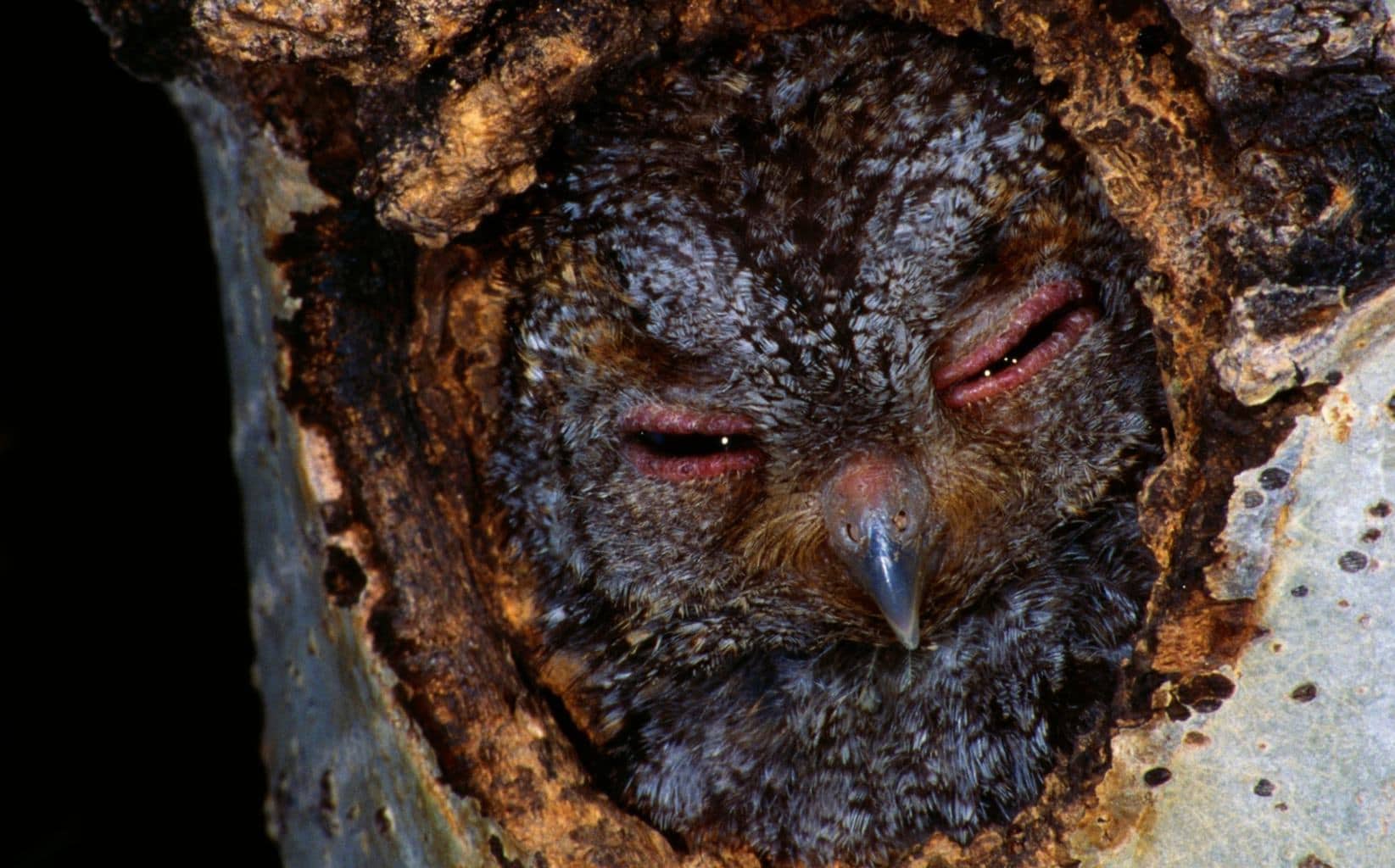
- Scientific name: Psiloscops flammeolus
- Length: 5.9-6.7 inches
- Weight: 1.5-2.2 oz
- Wingspan: 15.9-16.1 inches
The Flammulated Owl is a tiny owl that’s even smaller than a robin. It has black eyes with a V-shaped brownish patch covering them. It is grey-colored with tight bands of reddish-brown and white. It has small ear tufts, which aren’t really ears but feathers, and they’re mostly flattened. It also has fiery rimmed wings.
Unlike other owls, whose favorite meal is rodents, this one’s diet is based on insects. It’s mostly found in montane pine forests in Central America and Mexico.
Great Gray Owl
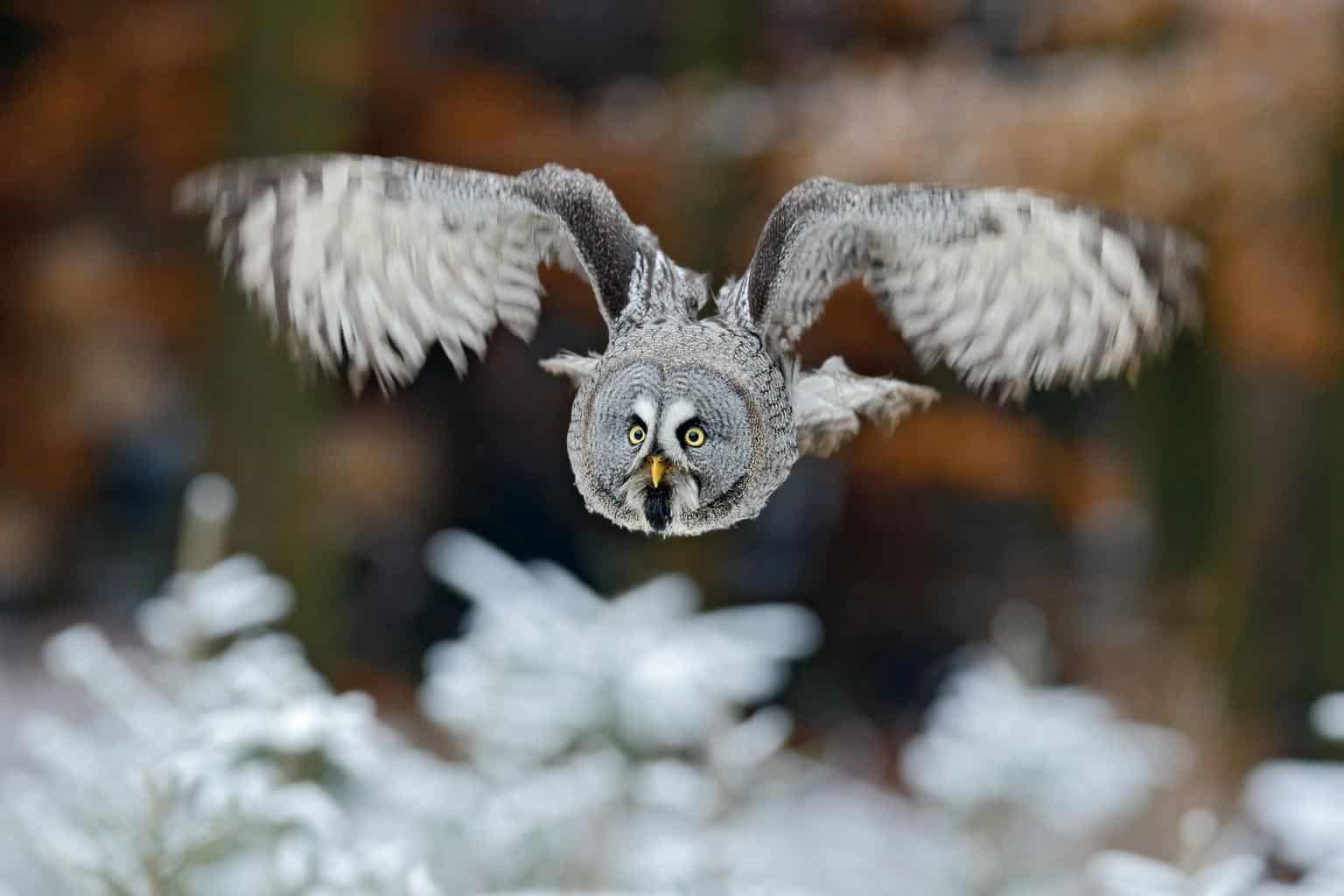
- Scientific name: Strix nebulosa
- Length: 24.0-33.1 inches
- Weight: 24.7-60.0 oz
- Wingspan: 53.9-60.2 in
The Great Gray Owl is gray with heavy brown barring. It also has a yellow bill and eyes. Besides that, its features are exceptionally unique. It has a pair of eyebrows that continue down to the bill as two crescents. It also has a little beard consisting of mixed black and white feathers. Lastly, it has a thick-feathered gray head that reminds one of a judge’s wig.
The Great Gray Owl is mostly found in dense coniferous forests in Alaska, through Canada, Asia, and Europe.
Great Horned Owl
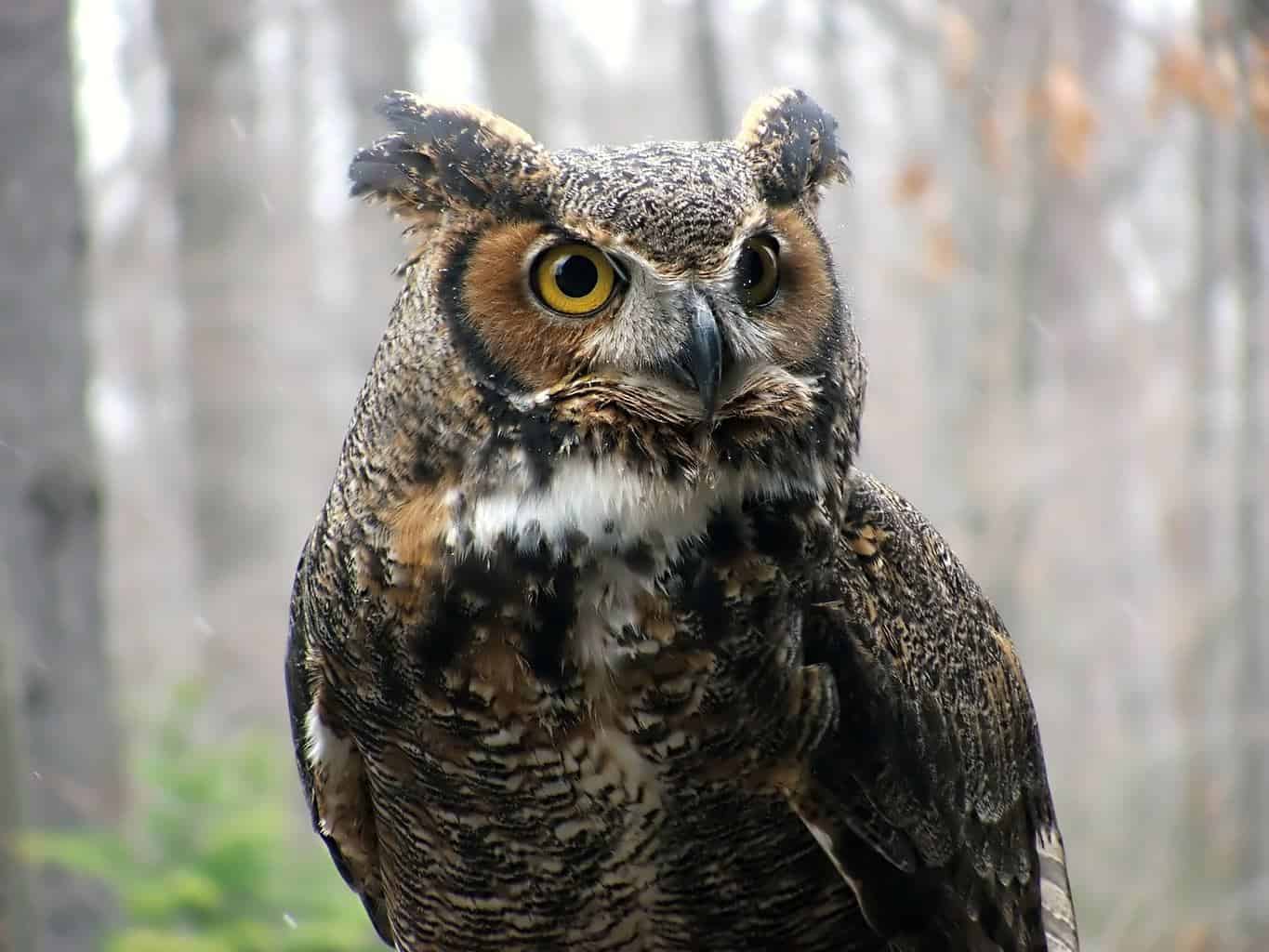
- Scientific name: Bubo virginianus
- Length: 24 inches
- Weight: 32.1-88.2 oz
- Wingspan: 39.8-57.1 inches
The Great Horned Owl is dark grey mottled with beige. It has big grey ear tufts, which resemble horns, and yellow eyes.
It feeds on a broad diet that includes rodents, skunks, moles, other owls, and raptors. It’s also referred to as the “Tiger Owl”.
Its habitat is also varied. It lives in deserts, grasslands, forests, and next to streams, anywhere from the Arctic to South America.
Long-Eared Owl

- Scientific name: Asio otus
- Length: 13-16 inches
- Weight: 7.8-15.3 oz
- Wingspan: 36-42 inches
The Long-eared Owl is chocolate brown barred with white and streaked with a hint of orange. It’s famous for its long pair of ear tufts. They’re dark brown with a little orange and white like the rest of the body. It has yellow-orange eyes. The inner facial disc is white while the outer is orange.
Long-eared Owls are found across the Northern Hemisphere in dense forests if they’re roosting and in open areas when they’re hunting. They’re hard to spot, unlike the Short-eared Owls.
Northern Hawk Owl

- Scientific name: Surnia ulula
- Length: 14.2-17.7 inches
- Weight: 8.5-16.0 oz
- Wingspan: 27.9 inches
The Northern Hawk Owl is brown with white spots on the head and back. The chest, however, is barred with straight horizontal lines. Both its eyes and bill are yellow. Its face is white with spotting on the forehead and black borders on the sides of the head. Its overall appearance gives off hawk vibes.
It’s spotted in coniferous forests in Alaska, northern Canada, and across Russia. It’s rarely seen in Washington, so their sighting makes for a happy occasion.
Northern Saw-Whet Owl
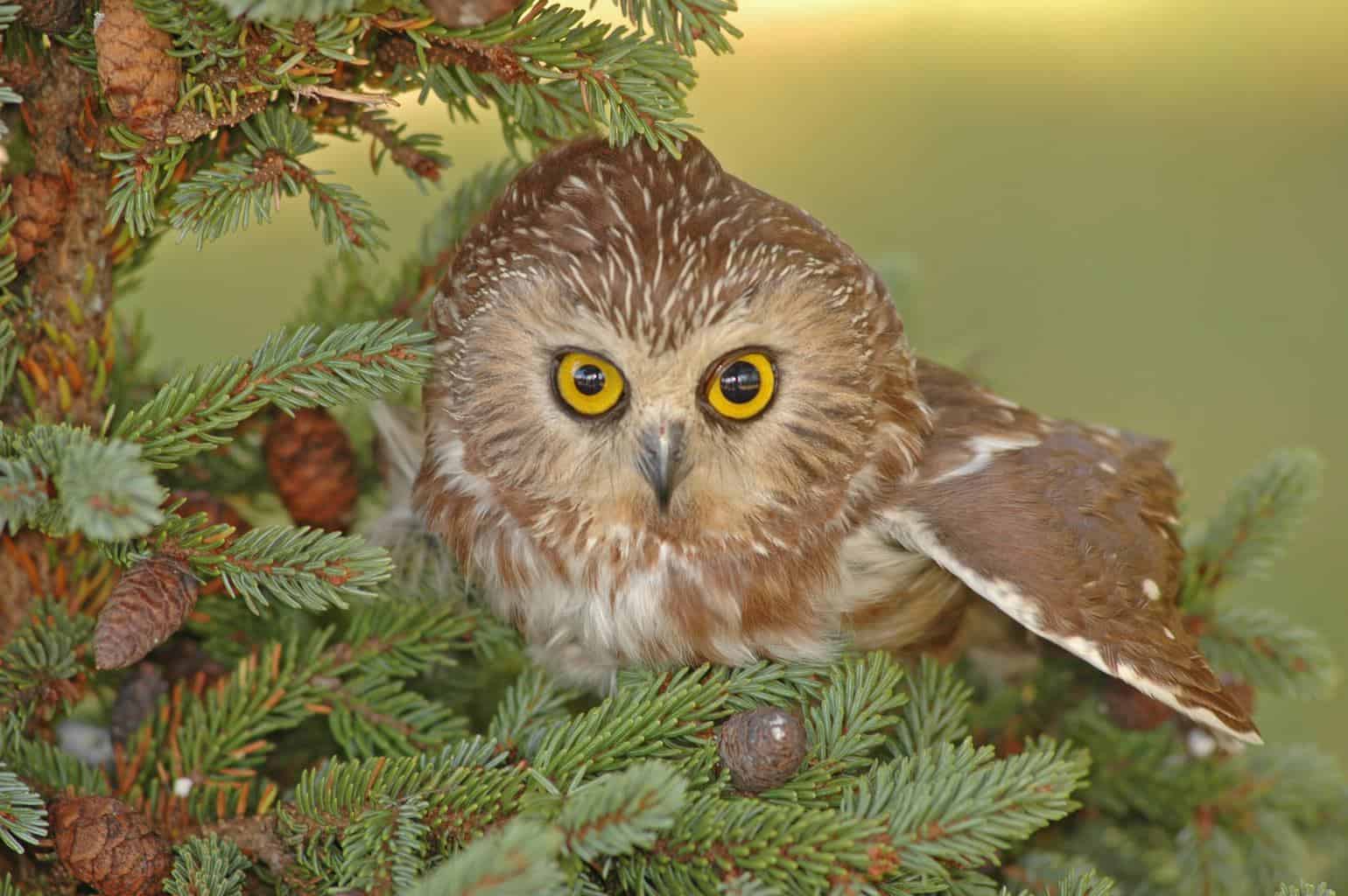
- Scientific name: Aegolius acadicus
- Length: 6.5-9 inches
- Weight: 2.3-5.3 oz
- Wingspan: 16.5-22.2 inches
Northern Saw-whet owls have large yellow eyes and white eyebrows. Their head is pale brown and fluffy. Their body is also light brown, streaked with white.
They live year-round in all kinds of forests in Washington. Nonetheless, they’re pretty small, nocturnal, and camouflaged, so they’re easy to miss.
Northern Spotted Owl
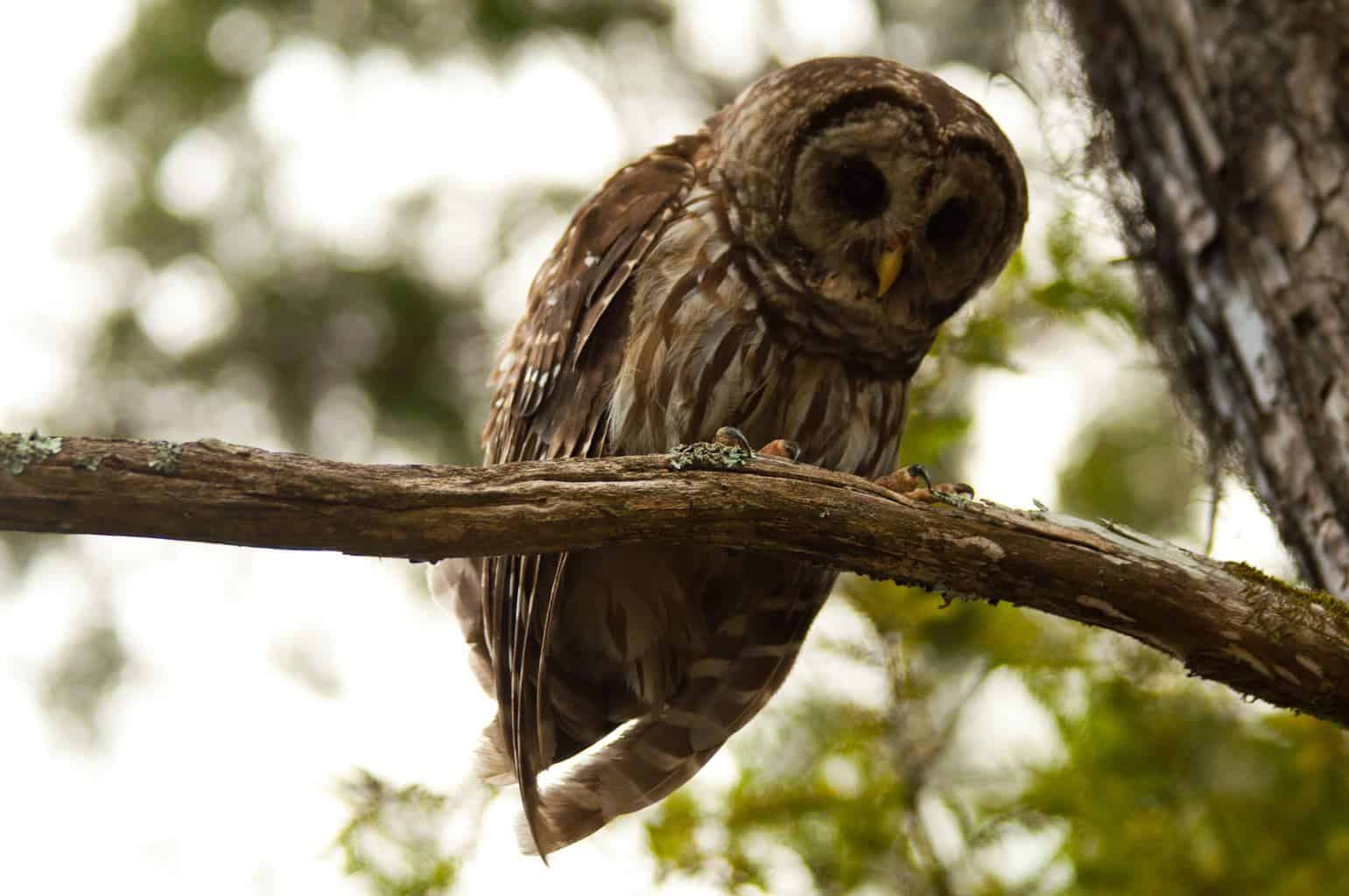
- Scientific name: Strix occidentalis caurina
- Length: 18 inches
- Weight: 17.6-24.7 oz
- Wingspan: 39.8 inches
The Northern Spotted Owl is dark brown with cinnamon and white spots the size of a fingerprint. The spotting on its head is a lot smaller and looks like freckles. It also has black eyes and a white facial disc.
Sadly, the Northern Spotted Owls are a threatened species, as their habitat is continually shrinking, and they’re facing competition from the invasive Barred Owl species.
They’re found in British Columbia and are dispersed across the United States in California, Oregon, and Washington.
Northern Pygmy-Owl

- Scientific name: Glaucidium californicum
- Length: 6.3-7.1 inches
- Weight: 2.1-2.5 oz
- Wingspan: 14.5-16 inches
Northern Pygmy-Owls are small but feisty. They’re brown with golden spots on their head and back. They have yellow eyes framed with a white unibrow that gives them an angry-bird look. And they have more white feathers on their neck and chest.
The most intriguing thing about the Northern Pygmy-Owl is the two black patches at the back of their heads. From afar, they look like a pair of unsettling eyes and are used as a defensive measure against predators.
Short-Eared Owl

- Scientific name: Asio flammeus
- Length: 13.4-16.9 inches
- Weight: 7.3-16.8 oz
- Wingspan: 33.5-40.5 inches
The Short-eared Owl is mustard-colored with heavy brown patches on the back and light ones on the chest. They have short ear tufts that aren’t visible to the casual observer. They have yellow eyes with black panda-like circles around them. The area around the bill and on the inner side of the eyes is white.
Short-eared Owls are the most widely distributed owls in the world. They’re sometimes called Marsh Owls because they nest in muddy lands, prairies, and tundra.
Snowy Owl

- Scientific name: Bubo scandiacus
- Length: 20.5-27.9 inches
- Weight: 56.4-104.1 oz
- Wingspan: 49.6-57.1 inches
As you can tell from its name, the Snowy Owl has gleaming white feathers. Its chest and back are covered in concise black barring, and it has yellow noticeable eyes.
It lives in the far north Arctic regions near the North Pole. It can also be found in America, Russia, Canada, and parts of Asia.
Its hunting ground of choice is tundra and plains where it flies low to the ground while looking for prey.
Western Screech Owl

- Scientific name: Megascops kennicottii
- Length: 7.5-9.8 inches
- Weight: 3.5-10.8 oz
- Wingspan: 21.6-24.4 inches
The Western Screech-owl’s plumage is a combination of gray and black shades. The feathers are veiny-looking and blend together. It has bright yellow eyes and a gray beak.
It’s hard to distinguish from the Eastern Screech-owl, but the two don’t exist in the same range.
Its range is the Western part of America and Canada. It lives in woods, streambeds, canyons, and semi-open areas at low elevations.
Wrap Up
As you can tell, Washington is home to a wide range of owl species from the brightest white owls to the chocolate brown ones, and from owls that burrow deep into the ground to others perching on the tops of mountains.
While some owls are big enough to hunt large raptors, others are even tinier than robins. Their diversity will keep you on the edge of your seat, waiting to catch sight of the next one on the list.
While some owls can be hard to find, we’re sure you’ll love the woodpeckers that come right to your door. Build some nests for both birds around your home and try your luck!

